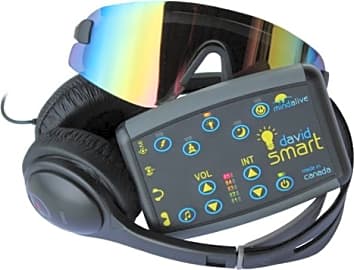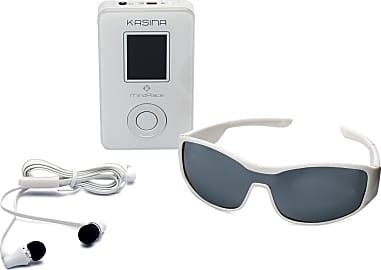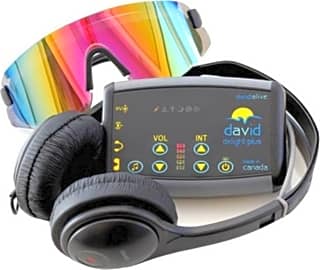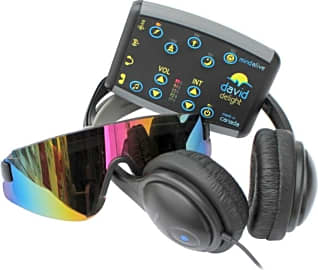The 8 Best Mind Machines

This wiki has been updated 45 times since it was first published in December of 2015. Having trouble sleeping? Feeling sluggish or anxious every day? Maybe you can't stop thinking about everything that happened at work. Users report that these mind machines can help with everything from general relaxation to improving focus, boosting energy levels, and even combating Seasonal Affective Disorder -- without drugs. Whether they'll work for you is hard to say, but they're worth a try. When users buy our independently chosen editorial choices, we may earn commissions to help fund the Wiki.
Editor's Notes
December 09, 2020:
We had to remove the Laxman Neurotronics Light and Sound and the Mindplace Procyon AVS Meditation System due to availability concerns.
We added the Huso Home, because even though it provides no visuals it delivers a very interesting combination of auditory and tactile stimulation thanks to its pads that can be placed on acupuncture meridians and which rhythmically pulse in conjunction with the device's preset audio tracks.
We considered adding the David Delight Biofeedback, but decided against it as the product lacked customer reviews and wasn’t clearly differentiable from the David Delight Plus.
These mind machines have a lot to offer, enough to justify their price tags. But if you're struggling with Seasonal Affective Disorder and reluctant to shell out the cash for one of these devices, you'd do well to check out the best therapy lamps.
July 01, 2019:
Mind machines are small electronic devices that, according to the claims of manufacturers and many users, can guide you into altered mind states using sounds and pulses of light. They can also be used in a meditation practice or just for the sheer entertainment value of a cool light and sound show. Users report that the devices are good for stress relief, relaxation, and even improved memory, among other things.
Be careful, though: one manufacturer (Mind Alive) warns that those with a history of seizures, including epileptics, should only use the devices under a doctor's supervision.
In this update, we evaluated our selections based on functionality and value, and added the Mind Alive David Smart. We like that it is aimed at college students, who need all the concentration and memory help they can get. Also removed an item due to concerns about its availability.
Special Honors
MindLightz App for iOS Developed by Mind Gear, the mindLightz app for Apple devices can mimic the isochronic tones and binaural sound-generation capabilities of a mind machine. When you pair the free app with the company's Bluetooth goggles, which are sold separately, you get a wireless audio-visual stimulation experience which is comparable to that delivered by dedicated mind machines. It includes 84 preset programs and also lets you create your own using any audio file from your library or streaming service. mindlightz.com
Your Reality Is The Best Kind Of Delusion
Seems like a series of crazy dots and smudges at first until–oh, what's that?
Our brains process information in some pretty amazing ways. Take a look at that picture there.
Seems like a series of crazy dots and smudges at first until–oh, what's that? You see a Dalmatian? Yeah, it is right there to the right of the image. Funny thing is, once you see it, you can't unsee it. It's one of the ways our brains process the information.
For a counter example, if you were to concoct a pair of glasses that flipped your image of the world upside down–the ceiling is the floor, the floor is the ceiling, etc.–it would only take a few days for your brain to actually flip the image back to right side up, and even less time to reset to normal once you removed the glasses.
Here, your brain can actually adjust through a process called perceptual adaptation, and it's one of the primary tenets of science upon which the mind machine is built.
It's not just visual systems, either. There's evidence of similar brain function applied to all five senses. And it's just these very kinds of mental manipulation that the mind machine seeks to achieve.
Very basically put, your brain waves flow at specific frequencies depending on short and long term stimuli, activity level, etc. A mind machine uses our brain's natural ability to latch onto, interpret, and adapt to incoming information to control the frequency of these waves, essentially reverse-engineering brain states.
Here's a metaphor: In New Jersey, among other states, independent driving schools teach their students in cars that are equipped with two steering wheels and two brake pedals, one on each side of the car. The idea is that if a student freaks out or loses control, the teacher can come in and take over the speed and direction of the car.
Now, a mind machine works on the same principal. Your brain is like a new driver, and if it's moving too quickly or in the wrong direction, the mind machine comes in like the teacher and redirects your brain's energy to make sure its following where you want to lead it.
Disclaimer: Please don't drive while using a mind machine.
Surfing The Brain Waves
Most people look pretty crazy, or at least a little bit like a bad sci-fi character, when using a mind machine. The likelihood is that, when you do use it, you're going to do so in the privacy of your own home, so style points don't count for much in the industry.
Others, however, only offer a few options, but they aren't any less expensive, and, they're often higher up on our list than the more expanded machines.
Still, the build of a given mind machine will have a lot to do with your comfort level when using it, and if you can't get comfortable the whole thing falls apart.
Beyond the obvious comfort consideration, you might notice that some mind machines come with a tremendous amount of sessions built into them. Some can even expand to even more. Others, however, only offer a few options, but they aren't any less expensive, and, they're often higher up on our list than the more expanded machines.
That makes sense of you think about it. We're not seeking to cater to the individual mind with these machines as much as we see to lasso the common brain wave frequency ranges and take control over them as described above.
Companies that have better reputations in the mindfulness and wellness communities have gained those reputations from stringent research and development, which tends to narrow down the number of necessary session options.
As Seen In The Flames
I promise not to spoil anything about a particularly popular high fantasy show airing these days, but I do use an image from it to point out something interesting about mind machines.
In ancient days, oracles and religious figures, fortune tellers and laymen all used fire for its mystical powers, for the effect it has, specifically, on the brain of the person looking into it.
Something soothing, sitting around the fire with people you care about.
There's something hypnotic about fire, isn't there? Something soothing, sitting around the fire with people you care about. We feel relaxed, sometimes so relaxed we start to share things we might otherwise keep in.
In a way, fire was an early mind machine, but not the first. That, if we're including the aural stimuli, would be the ocean, and I don't need to evoke the rhythm of crashing waves for you to know what effect that can have on your state of being.
These electronic mind machines, however, the systems designed to entrain your brain waves to a specific pulsing frequency of light and sound, began with experiments in the 1930s.
For the next fifty years, scientists and artists experimented with the technology, collecting the data that would become widely available to the public throughout the 80s and 90s, and is the groundwork for the mind machines we're looking at today.













